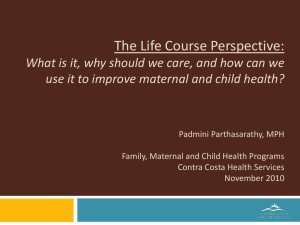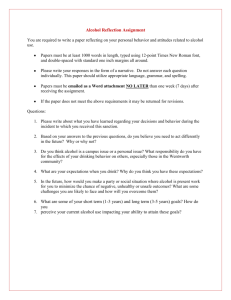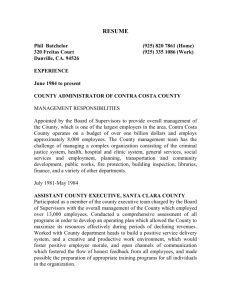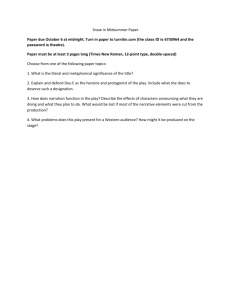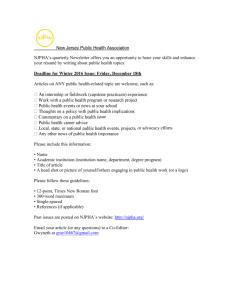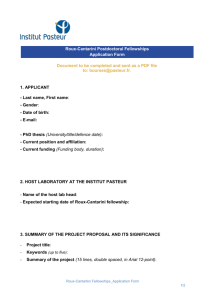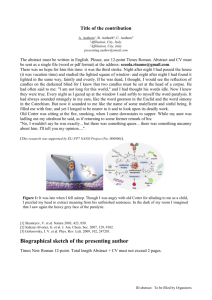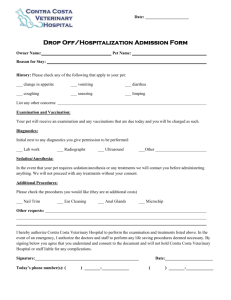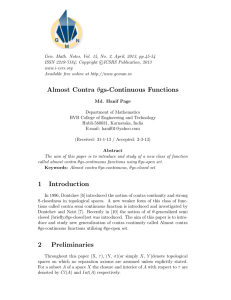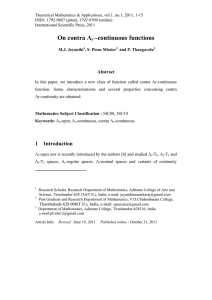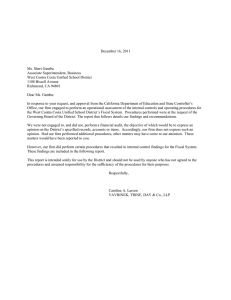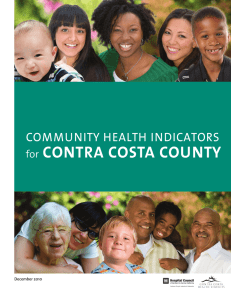Life Course Initiative Goals
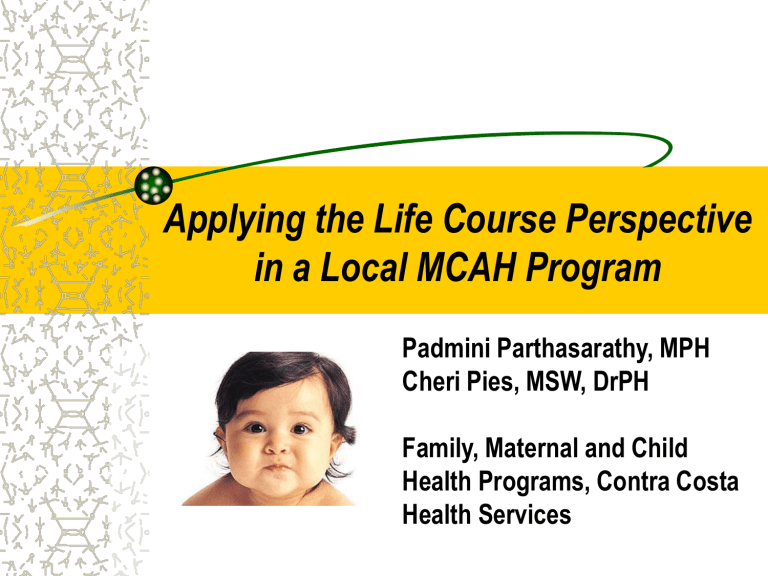
Applying the Life Course Perspective in a Local MCAH Program
Padmini Parthasarathy, MPH
Cheri Pies, MSW, DrPH
Family, Maternal and Child
Health Programs, Contra Costa
Health Services
Acknowledgements
Drs. Michael Lu and Neal Halfon, UCLA
Dr. Paula Braveman, UCSF
Contra Costa Health Services:
Cheri Pies, Director, FMCH Programs
Chuck McKetney, Epidemiologist
Debbie Casanova, Evaluator
Dawn Dailey, Program Manager
Overview
The Life Course Perspective
Health Equity and Social Determinants of Health
Life Course Game
Contra Costa Life Course Initiative
Our Road Map
Our First Destination: Building Economic
Security Today (BEST)
Life Course Perspective
A way of looking at life not as disconnected stages, but as an integrated continuum
Suggests that a complex interplay of biological, behavioral, psychological, and social protective and risk factors contributes to health outcomes across the span of a person ’ s life
Percent of Mothers who Received Early Prenatal
Care, by Race/Ethnicity, Contra Costa, 2004-2006
84
82
80
78
76
74
94
92
90
88
86
93.1
82.3
81.5
White African-
American
Source: Contra Costa County’s Automated Vital Statistics System (AVSS)
Latina
90.3
87.6
Asian/Pacific
Islander
CCC Overall
Rate of Low Birth Weight Births (per 100 live births), by Race/Ethnicity, Contra Costa, 2002-2004
14
12
10
8
6
6.2
12.9
5.6
7.8
4
2
0
White African-
American
Latino
Source: California Department of Health Services, Birth Statistical Master Files, 2002-2004
Asian/Pacific
Islander
6.8
CCC Overall
Infant Mortality Rate (per 1,000 live births), by Race/Ethnicity, Contra Costa, 2003-2005
10
9
8
7
6
3
2
5
4
1
0
2.8
8.8
4.9
4.1
White African-American Latino CCC Overall
Source: California Department of Health Services, Birth Statistical Master Files and Death Statistical Master Files, 2002-2004
The Life Course Perspective
(Lu and Halfon, 2003)
Protective factors
Risk factors
Key Concepts
Early Programming
Cumulative Pathways
Latina Paradox
Latinas living in the United States but born abroad have birth outcomes similar to White women
Birth outcomes worsen with each following generation
Disparity, Inequality, or Inequity?
HEALTH DISPARITY = INEQUALITY = difference in the health status of two groups
HEALTH INEQUITY = systematic and unjust differences in the distribution of illness and disease; differences are unnecessary and avoidable
Not all inequalities are unjust, but all inequities are the product of unjust inequalities.
Social Advantage and Health
Across Lifetimes and Generations
Prepared for the Robert
Wood Johnson Foundation by the Center on Social
Disparities in Health at the
University of California, San
Francisco.
The Life Course Game
The Life Course Initiative
Launched in 2005
A 15-year initiative
Based on the Life Course
Perspective and a 12-Point
Plan to close the Black-
White gap in birth outcomes
Life Course Initiative Goals
Reduce health disparities and health inequities
Optimize reproductive potential
Create a paradigm shift in MCH work
Life Course Initiative Goals
To change the health of a generation
Life Course Initiative Activities
Staff education
Laying the groundwork with higher- level management
Interconception care
Evaluation
Developing a new intervention
Evaluation
Established Life Course Initiative Data Team, which meets regularly
Conducted survey of Family, Maternal and Child
Health Programs staff
Identifying “intermediate outcomes” as measurements of success of Life Course-related activities (vs. long-term perinatal outcomes)
Our Road Map:
A 12-Point Plan…
To close the Black-White gap in birth outcomes
Goes beyond prenatal care
Goes beyond individuallevel interventions
Goes beyond the medical model
Our Road Map:
A 12-Point Plan
1. Provide interconception care to women with prior adverse pregnancy outcomes
2. Increase access to preconception care for
African American women
3. Improve the quality of prenatal care
4. Expand healthcare access over the life course
Our Road Map:
A 12-Point Plan
5. Strengthen father involvement in African
American families
6. Enhance service coordination and systems integration
7. Create reproductive social capital in African
American communities
8. Invest in community building and urban renewal
Our Road Map:
A 12-Point Plan
9.
Close the education gap
10. Reduce poverty
11. Support working mothers and families
12. Undo racism
Our Road Map:
A 12-Point Plan
Our First Destination
Increased financial security and stability and improved financial status
Building Economic Security Today
(BEST)
Asset development pilot project
Reduce disparities and inequities in health outcomes by improving financial security and stability
Home visiting programs & WIC
How does BEST fit into the 12-Point Plan?
9. Reduce poverty
10. Support working mothers and families
Generational Financial Fitness
Children learn about how to manage money from their parents
Financial education for parents now financial stability in next generation
Project Activities
Life Course Data Team: Evaluation Plan
Staff trainings
Unnatural Causes
Applying for grants
Partnerships
Developing home visiting and WIC interventions
Intermediate Outcomes
Staff:
Increased knowledge
Improved skills
New practices
Intermediate Outcomes
Clients:
Increased knowledge
Improved ability
Adopt at least one asset development strategy
Intermediate Outcomes
System:
Stronger community partnerships
More supportive health and human services system
Integration of asset development strategies into FMCH Programs’ infrastructure
BEST project development documentation
Long-Term Outcomes
Family income for daily living maximized
Preservation of and increase in financial assets
Increased financial security and stability, and improved financial status
Increased access to care, improved housing, better neighborhoods, increased food security, decreased violence, etc.
Improved health outcomes and financial status for future generations
Challenges
Making paradigm shift and gaining staff buy-in is a slow process
Addressing financial status and security sensitively
Learning and integrating many new concepts
Time and financial resources
Measuring success
Lessons Learned
Flexible timeline in order to accommodate program priorities
Opportunities to collaborate with new partners
Develop evaluation plan while developing program interventions
Unique approach re-energizes both staff and community partners
What will success look like?
For More Information
Padmini Parthasarathy
925-313-6178 pparthas@hsd.cccounty.us
